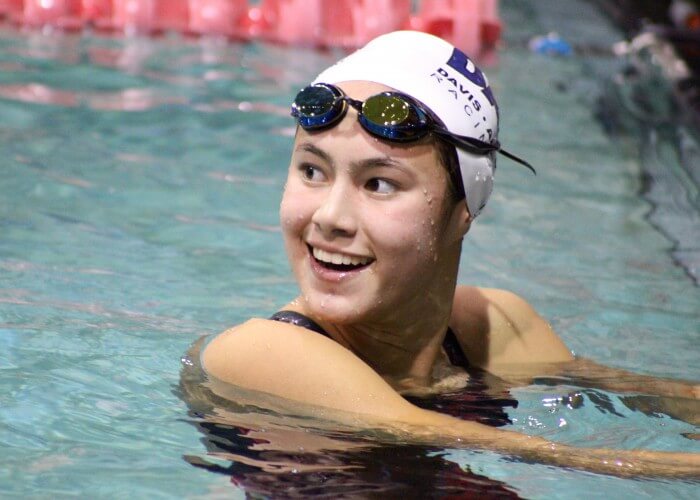3 Ways to Improve Training with Fitness Trackers

By Allison Pierce, Swimming World College Intern
We have all been there before–those practices where you find yourself thinking, “I don’t think my body will let me continue.” Whether it’s from lack of food or sleep, we often encounter sets that are simply too difficult to finish strong. A great aid in overcoming this mid-practice slump is a fitness tracker. Once used solely by runners and cyclists, these devices are increasingly showing up on swimmers’ wrists.
While there are a variety of waterproof fitness tracker products on the market today, swimmers interviewed for this article all happen to use the Speedo Shine by Misfit. This fitness tracker is waterproof up to 50 meters, counts laps, and helps set daily goals through a points system. Like other fitness trackers, the Shine also has its own application for mobile devices to help track a wide variety of training elements – from food intake to calories burned and sleeping patterns.
Here are three ways that fitness trackers like the Shine can specifically benefit swimmers.
1. Calories Burned and Consumed
As swimmers, we need enough calories from quality foods to fuel effective practices. From the weight room to the pool, or even just walking to classes, swimmers burn tons of calories. But exactly how many are you burning? One of the nice things about a fitness tracker is that it counts calories expended whenever you are active. As a swimmer, the results can be surprising. Personally, with an hour of weights and a two hour swim practice along with regular daily activities (i.e. brushing your teeth, walking, etc.), my fitness tracker tells me I burn almost 3,000 calories in a day–up to 1,400 more than the average adult.
In order to make sure your body has enough fuel to get through these workouts, you can enter your meals and snacks into your wearable brand’s application. The app then calculates your total calorie intake along with the nutrition facts for each food. This allows you to have a basic understanding of the various nutrients you are getting, such as protein and carbohydrates.
Varsity swimmer Stephanie Nemeth of Miami University has found the calorie tracker to be quite valuable. Nemeth stated, “I knew which days I might have trained harder, which then required me to replenish with extra protein or carbs during my meals.” Her teammate Shay Spelman agrees. “I think it has made me more aware of how much energy I burn every day and what I need to be eating to replenish what I burn.”
2. Sleep

Photo Courtesy: A. Weisenfels
Although sleep is crucial to having a good practice, swimmers tend to sleep less than we should in our busy lives. The sleep tracking feature available on most fitness trackers is a great way for swimmers to know how much sleep you actually get. It is a favorite one for Spelman and Sun Prairie (Wisconsin) High School swimmer Jacob Brehmer. The Speedo Shine tracks exactly how many hours and minutes of sleep you get each night, along with the amount of time you spend in “light sleep” compared to “deep sleep.”
Brehmer explains, “[My favorite part is] that it keeps track of how much sleep I am getting, and when in the night I am in a deep sleep or light sleep.”
Understanding how much sleep you get during any given night will also help you make adjustments in the future, which can help improve your training. Spelman states, “My favorite part is the sleep tracking function. It helps me realize how much sleep I am getting (or not getting) on any given day. By using the sleep tracking, I can see what I did in the day that could affect how I slept and make appropriate changes.” Spelman also notes that, “I have noticed that by working to increase my sleep I have done better in the pool.”
3. Achieving Daily Goals

Photo Courtesy: Taylor Brien
Swimmers are also known for being goal oriented. We are constantly focusing on short-term goals in order to strive towards our long-term ones. The daily goal feature applicable to most fitness trackers helps keep short-term goals in mind, such as a Fitbit which emphasizes getting 10,000 steps in one day. On The Shine, there is a point system that goes towards your physical activity. The more activity you do, the more points you earn. You can also set a goal for the amount of sleep you want each night.
Brehmer found this feature to be the most useful in his training. He states, “I think it has helped me especially during dryland to see how active I am being and how much progress I am making toward my daily goal.” Brehmer’s daily goal consists of 1,000 points, which can be achieved through 45 minutes of swimming, 30 minutes of running, or walking for one and a half hours. He also has a sleep goal of eight hours a night.
The daily goal can also be adjusted depending on how active you are over different periods of time. For example, Nemeth explains that during swim season, her goal was 3,000-3,500 points. She adds, “Now that I’m a swammer, I try to reach 1,000-1,500.”
Understanding how much energy you give your body through calories and sleep, combined with striving towards daily goals will help you get through those tough practices with ease.




great work
Amy Pfeiffermaybe I should start swimming again…
What’s up, I desire to subscribe for this website to obtain hottest updates, so where can i do
it please help.